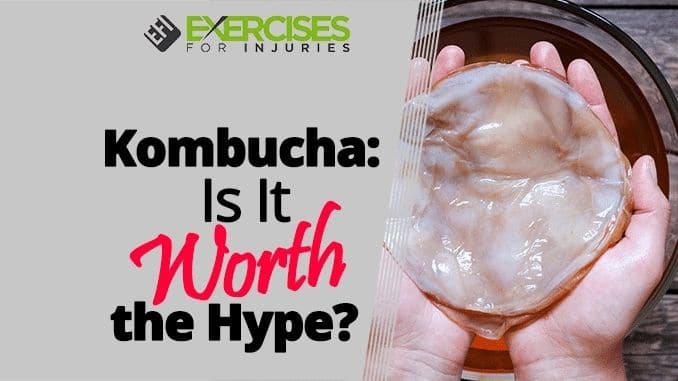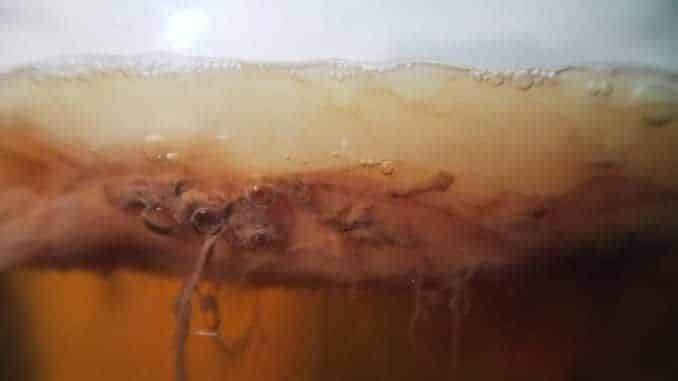
Kombucha tea (KT) is a fermented, lightly effervescent beverage that is quickly becoming the drink du jour. (Not to be confused with konbucha, a Japanese drink made with dried seaweed.) Moreover, many claims attribute health benefits to the beverage ― almost as many claims as you’ll find stories in the popular press and on lifestyle websites. Is kombucha worth the hype? Claims from such sites vary widely, and no two lists are the same. Almost all cite favorable effects on the gastrointestinal (digestive) system. None of the so-called favorable health claims are, however, substantiated by medical and scientific data collected through reliable, reproducible research. There are numerous reports of serious, even fatal, adverse effects documented by both valid research and anecdotal accounts.
Understanding Kombucha: Myths, Facts, and Prudent Approaches
History, composition, production, claims about health benefits and side effects as well as adverse and threatening reactions attributed to kombucha, are discussed. Moreover, facts are presented and substantiated, most from the National Library of Medicine of the National Institutes of Health. Kombucha is not recognized as a health agent by the National Institutes of Health’s National Center for Complementary and Integrative Health.
Moreover, this article about kombucha is intended for education only. It is not intended to offer opinions about kombucha’s effects on health. It is not an endorsement of the substance nor a recommendation for its use. As you learn, bear in mind the majority positions of respected medical and scientific communities, succinctly stated by Brent A. Bauer, M.D., of the Mayo Clinic, Rochester, Minnesota: “ … there isn’t good evidence that kombucha tea delivers on its health claims. At the same time, several cases of harm have been reported. Therefore, the prudent approach is to avoid kombucha tea until more definitive information is available.” An example of this is that kombucha should not be consumed by pregnant and lactating women.
Kombucha Through the Years
The first recorded use of kombucha was in 221 B.C., in Manchuria, during the Tsin dynasty. It was called “the tea of immortality.” Kombucha has been used in Japan, Europe and Russia for centuries. The name “kombucha” was first applied in Japan, 415 A.D. It is sometimes called “mushroom tea,” although kombucha is not a mushroom and contains no mushrooms.
Furthermore, traditionally, kombucha was home or locally made. In the 1990s, mass-production and bottling led to distribution throughout Europe and the United States. Within the last two to three years, the number of users has been growing rapidly. Is kombucha worth the hype? The market for kombucha is expected to grow 25 percent per year until 2020. Millennials, born 1982-2000, consume the most kombucha, but consumption among Generation Xs, born between the mid-1960s to the early 1980s, isn’t far behind.
Moreover, today, kombucha is sold worldwide in retail food stores in a variety of flavors. The kombucha, its components and starter kits can be purchased on several websites; an electronic journal devoted to kombucha is published in more than 30 languages.
Composition and Production
Kombucha starts with black or green tea leaves added to boiling water and allowed to steep for 10 minutes and then sweetened, usually with sucrose. Moreover, it’s acidified by vinegar or already prepared kombucha, as a “symbiotic ‘colony’ of bacteria and yeast (SCOBY),” added to initiate fermentation. The principle yeast in the SCOBY is usually Saccharomyces cerevisiae, but Brettanomyces bruxellensis, Candida stellata, Schizosaccharomyces pombe and others are used in lesser numbers. Moreover, the yeast reacts with the sucrose to produce fructose and glucose. The process produces alcohol and a slight effervescence.
Kombucha Fermentation and Culture Development: From Bacterial Components to Optimal Incubation
The bacterial component of a SCOBY is virtually always Gluconacetobacter xylinus, although there may be one or more additional types of bacteria in lesser numbers. Is kombucha worth the hype? Moreover, the bacteria react with the alcohols, oxidizing them to acetic and other acids. Moreover, without oxidation, the drink may be up to 5 percent alcohol. Early in kombucha’s introduction to the United States, retail sales were temporarily banned in the U.S., because the ethanol content was sometimes greater than 5 percent. Currently, the ethanol in commercially bottled kombucha is less than 1.0 percent and is limited by law.
Furthermore, the preparation is covered and incubates for one to eight weeks. Moreover, the optimal temperature for incubation is 68 to 72 degrees Fahrenheit―although temperatures of 64 F to 79 F are acceptable. The growth of undesirable organisms is inhibited by the addition of the small amount of previously fermented kombucha, which lowers the pH level. The fermentation and conversion processes accelerate for the first four days, then the rate of the processes declines, helping to limit the ethanol content.
Moreover, the new culture forms a clear, thin, gel-like membrane on the surface of the liquid. The tea will start to smell fermented and gas bubbles will appear. Moreover, after 10 to 14 days, a new tea fungus, about two centimeters thick, has developed. During the early incubation, the kombucha has a pleasant, fruity, sour-like, sparkling taste, but gradually, over a few days, assumes a mild vinegar-like taste. Moreover, the tea fungus is removed and kept in a small amount of tea, and the drink stored in capped bottles at 4 degrees centigrade.
SCOBY Composition and Kombucha Cultivation: Insights into Metabolites and Sustainable Applications
Furthermore, the SCOBY has, in lesser amounts, polyphenols, enzymes, glycerol and lactic acid. Usnic acid, which is toxic to liver cells, was found in one study, but not in subsequent research. Moreover, the acid is naturally occurring in lichens and is known to deactivate some groups of viruses. Additionally, the chemical reactions of the SCOBY form a thick, gelatinous, cap-like mass on the surface of the tea. It resembles a mushroom cap ― hence the moniker “mushroom tea.” Moreover, the metabolite composition and concentration vary with the substances used to produce the kombucha.
When kombucha is cultivated at home, there is more concern about potential contamination by disease-causing bacteria, compared to kombucha produced commercially. Kombucha should be prepared and stored in glass containers previously sterilized in boiling water. Using glass avoids leaching of toxic substances, such as lead, from containers into the product.
Interestingly, when dried, the culture forms a leather-like textile known as microbial cellulose. It’s sustainable and compostable and can also be used as a dye. Moreover, in 2014, one designer debuted a clothing collection made entirely of the kombucha textile.
Claims of Health Benefits
Moreover, advocates of kombucha ingestion claim effects and benefits to all body systems, functions, and ailments. Some sound potentially valid, but some are transparently preposterous. Some claims are even dangerous, such as the declaration that kombucha inhibits cancers. Moreover, it must be kept in mind that none of the health benefits claimed have been substantiated by rigorously controlled, reproducible research. Is kombucha worth the hype? It is beyond the scope of this article to list or discuss all the claims made
- Enhances cognition
- Supports weight loss and regulates appetite
- Stimulates the immune system
- Treats all ailments
- Promotes longevity
- Induces synthesis of B vitamins and folic acid
- Detoxifies (not defined) the body
- Reduces blood cholesterol
- Reduces inflammatory problems (not defined)
- Alleviates arthritis, rheumatism and gout symptoms
- Promotes liver functions
- Normalizes (not defined) intestinal activity, balances intestinal flora and cures hemorrhoids
- Prevents/heals bladder infections and reduces kidney calcifications
- Stimulates glandular (not defined) systems
- Protects against diabetes
- Increases resistance to cancer
- Has antibiotic effects against bacteria, viruses and yeasts
- Stimulates interferon production
- Relieves bronchitis and asthma
- Reduces menstrual disorders
- Reduces menopausal hot flashes
- Improves hair, skin and nail health
- Reduces alcohol cravings of alcoholics
- Reduces nervous disturbances (not defined)
- Reduces stress (not defined)
- Reduces insomnia
- Reduces headaches (type not defined)
- Improves eyesight
- Counteracts aging problems (not defined)
Some kombucha zealots speak of it as a miracle potion that can eliminate gray hair, increase libido, be used as a household cleaner, a soothing foot soak and underarm deodorant.
Evidence of Toxicity
Moreover, it is apparent that kombucha is a source of a wide range of bioactive substances that are digested, absorbed and metabolized by the body, exerting effects at a cellular level. Adverse side effects and health disorders have been reported: These include but are not limited to:
- Nausea
- Allergic reactions
- Acid sensitivities
- Severe metabolic acidosis
- Hepatotoxicity (liver)
- Renal (kidney) failure
- Lead poisoning
- Severe skin diseases
Furthermore, a married couple who had been drinking tea brewed in a ceramic pot with a lead-containing glaze developed symptomatic lead poisoning that required chelation therapy ― the injection of chemicals that bind to lead and eliminate it gradually. Moreover, there are cases of anemia in kombucha users, associated with lead poisoning from glazed earthenware jugs. Moreover, acute renal failure with lactic acidosis and hyperthermia within 15 hours of consumption of kombucha, in a young man who was HIV-positive, have been reported. Contaminants have been suggested as a potential source of adverse reactions.
Moreover, is kombucha worth the hype? Recommendations have been made to kombucha users to “drink plenty of water to facilitate the elimination of toxins (unspecified) and to adjust consumption to any reaction of the body.” That statement is too ambiguous to be useful, as is “persons suffering from severe afflictions should be aware of side effects brought about by kombucha consumption.”
“Common sense should be used to discard products with an abnormal odor and color,” advise Dufresne and Farnworth in “Tea, Kombucha, and health: a review.” Considering the nature of kombucha and lack of its familiarity, what is a normal odor and color? To neophyte observers, an ugly, spongy-looking mushroom floating atop a cloudy, brown broth is not an appealing sight.
Drug Interaction
Disulfiram (Antabuse) is a drug that may be prescribed for alcohol abusers to support abstinence from alcohol. Kombucha and disulfiram can interact to cause a pounding headache, vomiting, flushing and other noxious effects. They must not be ingested together. Kombucha should not be used within several days after taking disulfiram.
Conclusion
Is kombucha worth the hype? A more scientific approach could serve to separate real, beneficial effects of kombucha from invalid claims of health benefits. More information about the biological and chemical mechanisms of action is needed to appreciate kombucha’s values and limitations.
If you want to know what foods will help you restore your natural vitality and get slim and stay slim, then click here to check out the Best Foods That Rapidly Slim & Heal In 7 Days program, here!



